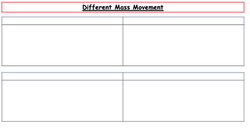top of page
IB

|Geophysical Hazard Lesson's |
|Content|
The distribution of geophysical hazards (earthquakes, volcanoes, mass movements)
The relevance of hazard magnitude and frequency/recurrence for risk management
Geophysical hazard risk as a product of economic factors (levels of development and technology), social factors (education, gender), demographic factors (population density and structure) and political factors (governance)
Geographic factors affecting geophysical hazard event impacts, including rural/urban location, time of day and degree of isolation.
|Lesson|
|Lesson 2
|Lesson 1|
 |  |
|---|
|Reading/Revision & Assessment|
|Earthquakes|
Two earthquake hazard events of similar magnitude, but with contrasting human impacts
-
Characteristics of earthquakes (depth of focus, epicentre and wave types) caused by varying types of plate margin movement and human triggers (dam building, resource extraction); and associated secondary hazards (tsunami, landslides, liquefaction, transverse faults)
-
geophysical hazard event profiles, including any secondary hazards
-
varied impacts of these hazards on different aspects of human well-being
-
why levels of vulnerability varied both between and within communities, including spatial variations in hazard perception, personal knowledge and preparedness
|Lesson 3|
|Lesson 4|
 |  |
|---|---|
 |
|Lesson 5|
|Reading/Revision & Assessment|

Tip:Ensure to have a good understanding of P and S waves. To be able to explain the formation of Earthquakes.
|Case Studies|
|Content|
|Volcano|
Two Volcanic hazard events in contrasting plate boundary locations.
-
Characteristics of volcanoes (shield, composite and cinder) formed by varying types of volcanic eruption; and associated secondary hazards (pyroclastic flows, lahars, landslides)
-
geophysical hazard event profiles, including any secondary hazards
-
varied impacts of these hazards on different aspects of human well-being
-
why levels of vulnerability varied both between and within communities, including spatial variations in hazard perception, personal knowledge and preparedness
|Lesson|
|Lesson 6|
 |
|---|
|Reading/Revision & Assessment|
|Case Studies|
|Media in the Classroom|
Eyjafjallajökull
Montserrat
|Content|
|Lesson 7
|Land mass Movements|
|Lesson 7|
|Lesson 8|
Two mass movement hazard events with contrasting physical characteristics (fast/slow; solid/loose)
-
Classification of mass movement types according to cause (physical and human), liquidity, speed of onset, duration, extent and frequency
-
geophysical hazard event profiles, including any secondary hazards
-
varied impacts of these hazards on different aspects of human well-being
-
why levels of vulnerability varied both between and within communities, including spatial variations in hazard perception, personal knowledge and preparedness
 |  |
|---|---|
 |
|Lesson 9|
|Reading/Revision & Assessment|
|Content|
|Case Studies|

Constrasting Case Study Land Mass Movements
|Lesson|

China landslide death toll rises to 31 after dozens buried in freezing winter temperatures
Volcanic Processes—Landslides Reading
|Vulnerability|
|Lesson 10|
|Lesson 11|
For each geophysical hazard type, the case studies should develop knowledge and understanding of:
– geophysical hazard event profiles, including any secondary hazards
– varied impacts of these hazards on different aspects of human wellbeing
– why levels of vulnerability varied both between and within communities, including spatial variations in hazard perception, personal knowledge and preparedness
 |  |
|---|
|Content|
|Lesson|
|Risk and risk assessment|
|Lesson 12|
Pre-event management strategies for mass movement (to include slope stabilization), earthquakes and tsunami (to include building design, tsunami defences), volcanoes (to include GPS crater monitoring and lava diversions) Post-event management strategies (rescue, rehabilitation, reconstruction), to include the enhanced use of communications technologies to map hazards/disasters, locate survivors and promote continuing human development
 |
|---|
|Media in the Classroom|
|Reading/Revision & Assessment|

Lesson 8 Research instructions

Lesson 8 Reading

Lesson 8 Card sort

Lesson 8 Homework

Lesson 8 Glossary

Lesson 9 Grading

Lesson 9 Grading
 |
|---|
|End of unit Assessment|
|Revision|
bottom of page
























